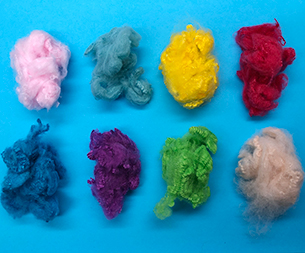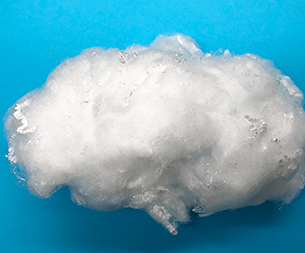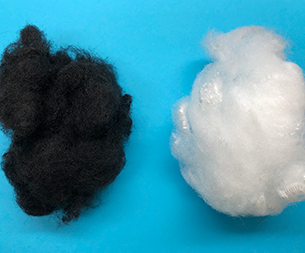What is the difference between polypropylene yarn and polyester yarn? Polypropylene is the trade name of polypropylene fiber. It is a fiber made from propylene as a raw material through polymerization and melt spinning. Polypropylene officially began industrial production in 1957 and is a rising star among synthetic fibers. Because polypropylene fiber has the advantages of simple production process, low product price, high strength and light relative density, polypropylene fiber has developed rapidly. Polypropylene is currently the fourth largest variety of synthetic fibers.
The production of polypropylene fiber includes staple fiber, filament and split film fiber. Polypropylene film fiber is made by first making polypropylene into a film, and then stretching the film to split it into a network of fibrils. Polypropylene is widely used in the manufacture of industrial fabrics and non-woven fabrics. Such as carpets, industrial filter cloths, ropes, fishing nets, building reinforcements, oil-absorbing blankets and decorative cloths. For civilian use, polypropylene can be spun purely or blended with wool, cotton or viscose to make various clothing materials. In addition, polypropylene film fibers can be used as packaging materials.
The main physical and chemical properties of polypropylene
1. Form The longitudinal surface of polypropylene is straight and smooth, and the cross section is round.
2. Density The biggest advantage of polypropylene fiber is its light texture. Its density is only 0.91g/cm3, which is the lightest variety among common chemical fibers. Therefore, polypropylene fiber of the same weight can obtain a higher coverage area than other fibers.
3. Strength and elongation Polypropylene has high strength, large elongation, high initial modulus and excellent elasticity. Therefore, polypropylene fiber has good abrasion resistance. In addition, the wet strength of polypropylene is basically equal to the dry strength, so it is an ideal material for making fishing nets and cables.
4. Hygroscopicity and dyeability Polypropylene has very little hygroscopicity, almost no moisture absorption, and the moisture regain under general atmospheric conditions is close to zero. But it has a wicking effect and can transmit water vapor through the capillary in the fabric, but it does not have any absorption effect. The dyeability of polypropylene is poor and the chromatogram is incomplete, but the original solution coloring method can be used to make up for the deficiency.
5. Acid and alkali resistance Polypropylene fiber has good chemical resistance. In addition to concentrated nitric acid and concentrated caustic soda, polypropylene fiber has good resistance to acids and alkalis, so it is suitable for use as filter materials and packaging materials.
6. Light resistance, etc. Polypropylene fiber has poor light resistance, poor thermal stability, easy aging, and is not resistant to ironing. But it can improve its anti-aging performance by adding anti-aging agent during spinning. In addition, polypropylene has good electrical insulation, but it is easy to generate static electricity during processing.
Polyester
(1) What is polyester?
Polyester is an important variety of synthetic fibers, and it is the trade name of polyester fiber in my country. It is a fiber-forming polymer made of purified terephthalic acid (PTA) or dimethyl terephthalate (DMT) and ethylene glycol (EG) through esterification or transesterification and polycondensation reaction- -Polyethylene terephthalate (PET), a fiber made by spinning and post-processing.
(2) What are the properties of polyester?
1. High strength. The short fiber strength is 2.6~5.7cN/dtex, and the high tenacity fiber is 5.6~8.0cN/dtex. Due to its low hygroscopicity, its wet strength and dry strength are basically the same. The impact strength is 4 times higher than nylon and 20 times higher than viscose fiber.
2. Good flexibility. The elasticity is close to that of wool, and it can almost completely recover when it stretches 5% to 6%. The wrinkle resistance is better than other fibers, that is, the fabric does not wrinkle and has good dimensional stability. The modulus of elasticity is 22~141cN/dtex, which is 2~3 times higher than nylon.
3. Good heat resistance.
4. Good water absorption.
5. Good abrasion resistance. The abrasion resistance is second only to the best abrasion resistance nylon, better than other natural fibers and synthetic fibers.
6. Good light resistance. Lightfastness is second only to acrylic. 7. Corrosion resistance. It is resistant to bleaching agents, oxidants, hydrocarbons, ketones, petroleum products and inorganic acids. It is resistant to dilute alkali, not afraid of mildew, but hot alkali can make it decompose.
8. The dyeability is poor.
(3) What are the major varieties of polyester?
The broad categories of polyester include staple fibers, drawn yarns, textured yarns, decorative filaments, industrial filaments, and various differentiated fibers.
- Polypropylene staple fiber is wi
- How to better exert the power of
- The characteristics of all aspec
- Internet technology changes cons
- Polypropylene staple fiber proce
- The traditional peak season has
- The performance advantages of Hy
- Operation analysis of China's in
- What factors are Polypropylene s
- From January to August this year
- Markets
- Automotive Products
- Nonwoven Lining
- Geosynthetics
- Liquid Filtration
- Apparel and Textiles
- Hygiene Products
- Building and Construction
- Other Markets
- Contact Us
- Contact Haibang





